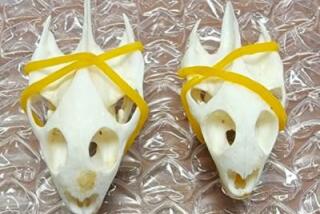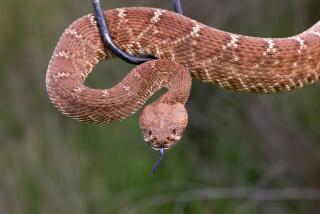Reptile performers of the first class
- Share via
SUPPLYING the reptiles for the suspense thriller “Snakes on a Plane,” which opens Aug. 18, was a dream job for Jules Sylvester. The snake wrangler, whose Los Angeles-based company is called Reptile Rentals Inc., has been working with reptiles for the last 39 years.
“I was trained at the Nairobi Snake Park in Kenya,” says Sylvester. “I lived in the bush most of my life, which is why I ended up catching snakes.”
Sylvester keeps at least 150 snakes at his company at all times. Only about 10% are venomous “because I have to have actors hold them. So 90% are manageable for actors.”
For “Snakes on a Plane,” which stars Samuel L. Jackson as an FBI agent escorting a witness on a flight from Hawaii to Los Angeles when assassins release hundreds of deadly snakes, Sylvester drove some 450 snakes from Los Angeles to the Vancouver location -- “I think there were 27 different species of snakes,” he says.
But only 60 were used at one time. “You have very controlled areas [on the plane] where you were shooting,” says Sylvester. “We mixed it with computer graphics and animatronic snakes.”
Because there were so many action sequences, the actors never mingled with the real snakes for fear of trampling the reptiles. “We kept it to stunt people and extras,” he says.
Sylvester prefers to use corn and milk snakes for films. “They are about 3 to 4 feet long. They look scary but are very gentle. They climb well, and you can dangle them around things.”
He also had cobras and rattlesnakes on the set for isolated shots that Sylvester describes as “quite terrifying. We got some tremendous stuff from one of the cobras,” says Sylvester. “He was very, very aggressive. He got frightened of his reflection in the window and hissed.”
Movie work, it seems, can be tiring for snakes. “They get shagged out,” says Sylvester. “If they get handled too much they get a bit floppy. They looked tired, and you don’t want to stress them out. That’s why you take doubles and triples, so you can put them on the back burner. You give them a week off so they can relax and eat.”
-- Susan King
More to Read
Sign up for The Wild
We’ll help you find the best places to hike, bike and run, as well as the perfect silent spots for meditation and yoga.
You may occasionally receive promotional content from the Los Angeles Times.







